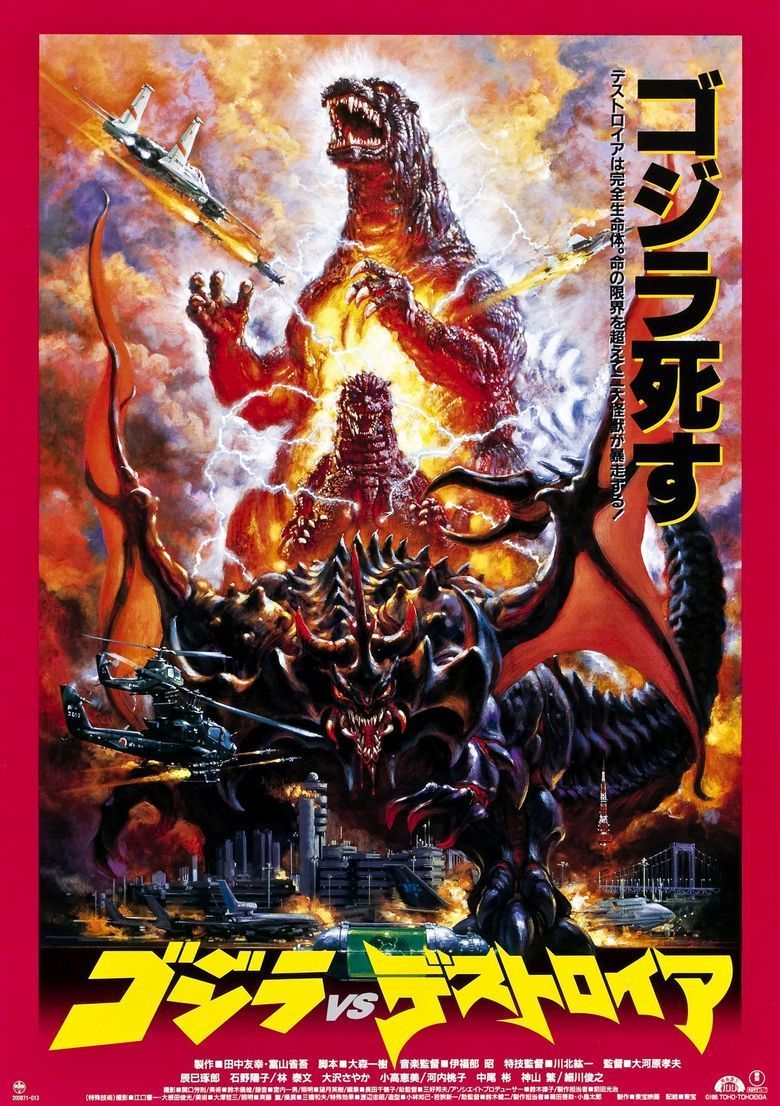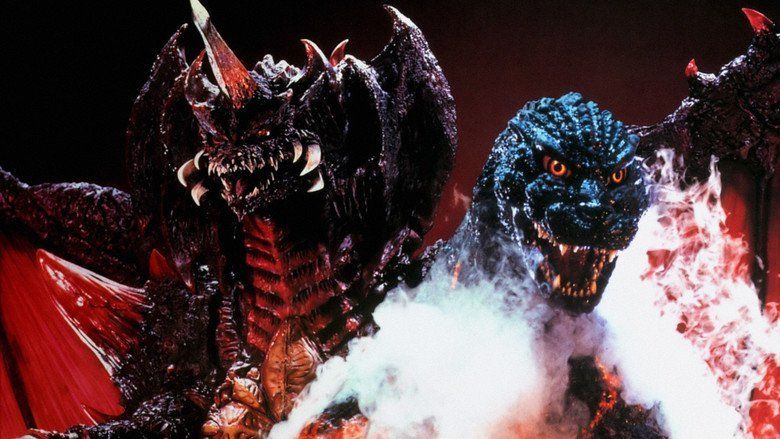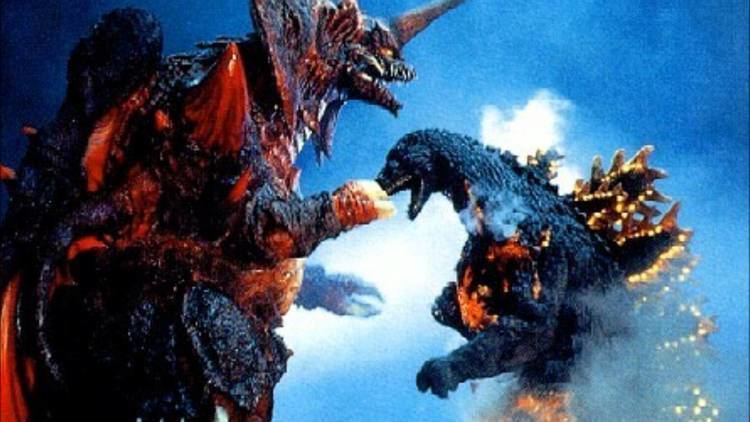Godzilla vs Destoroyah
7 /10 1 Votes7
Film series Godzilla Writer Kazuki Ohmori | 6.9/10 IMDb Genre Action, Horror, Sci-Fi Duration Country Japan | |||||||||||||||||||||||||||||||||
 | ||||||||||||||||||||||||||||||||||
Release date December 9, 1995 (1995-12-09) Cast Takurô Tatsumi (Dr. Kensaku Ijuin), Yôko Ishino (Yukari Yamane), Yasufumi Hayashi (Kenichi Yamane), (Miki Saegusa), Sayaka Osawa (Meru Ozawa), Saburo Shinoda (Professor Fukazawa)Characters Godzilla (Kenpachiro Satsuma), Destoroyah (Ryo Hariya), Godzilla Junior (Hurricane Ryu), Miki Saegusa (Megumi Odaka), Dr Daisuke Serizawa (Akihiko Hirata) Similar movies Blackhat , Cloverfield , 47 Ronin , The Last Samurai , Seven Samurai , The Poseidon Adventure Tagline Get Ready for a Three-Way Monster Melee! | ||||||||||||||||||||||||||||||||||
Godzilla vs. Destoroyah (ゴジラvsデストロイア, Gojira tai Desutoroia) is a 1995 Japanese science fiction tokusatsu kaiju film featuring Godzilla, produced and distributed by Toho. It is the 22nd installment in the Godzilla franchise and the seventh and final film in the Heisei series. The film is directed by Takao Okawara, written by Kazuki Ōmori and stars Takuro Tatsumi, Yōko Ishino, Yasufumi Hayashi, Sayaka Osawa, Megumi Odaka, Masahiro Takashima, Momoko Kochi, Akira Nakao, Shigeru Kamiyama and Saburo Shinoda. In Godzilla vs. Destoroyah, Godzilla is nearing a nuclear meltdown which threatens the Earth and to further worsen the situation, vicious creatures called Destoroyah emerge from the water and start terrorizing Japan, and the Japanese Self-Defense Force must come up with a daring plan to take down both threats.
Contents
- Depression anti bullying awareness godzilla vs destoroyah 1995
- Plot
- Cast
- Production
- Special effects
- Score
- English version
- Box office
- Critical reception
- Home media
- References

The film was released in Japan on December 9, 1995 and released direct-to-video in the United States in 1999 by Columbia TriStar Home Video. It was the last Godzilla film to be produced by any studio until 1998's Godzilla and the last Godzilla film to be produced by Toho until 1999's Godzilla 2000. The film received global publicity for Toho's announcement that they would kill Godzilla. It was the final film to be scored by Akira Ifukube before his death eleven years later.

Depression anti bullying awareness godzilla vs destoroyah 1995
Plot

Miki Saegusa of the United Nations Godzilla Countermeasures Center (UNGCC) travels to Birth Island to check on Godzilla and its adopted child, but finds the entire island destroyed. Godzilla appears in Hong Kong, covered in glowing lava-like rashes and goes on a rampage. The Japan Self Defense Forces (JSDF) hires college student Kenkichi Yamane, the grandson of Dr. Kyohei Yamane, to work at the center in an attempt to unravel the mystery of Godzilla's condition. Yamane suspects that Godzilla's heart, which acts as a nuclear reactor, is undergoing a nuclear meltdown as a result of Godzilla absorbing the energy released from a uranium deposit on Birth Island that had been triggered by a volcanic eruption. Yamane theorizes that, when Godzilla's temperature reaches 1,200 °C, it will explode with a force approximately "1,000 times greater than all nuclear weapons put together, a burst of power unseen since time began."

The JSDF deploys a flying combat vehicle outfitted with anti-nuclear cold weapons, the Super-X III, in an effort to reverse Godzilla's self-destruction. Meanwhile, scientists discover that Dr. Serizawa's Oxygen Destroyer, which was used against the original Godzilla in 1954, has awoken and mutated a colony of Precambrian organisms lying dormant in Tokyo Bay. The creatures combine into several man-sized crab-like creatures and begin wreaking havoc. After several deadly skirmishes with the JSDF, the creatures, dubbed "Destoroyah", evolve beyond the military's containment abilities.

Due to its encounter with the Super-X III, Godzilla will not explode, but will instead suffer a bodily meltdown which could potentially destroy the planet. Miki is instructed to telepathically lure Godzilla Junior to Tokyo, hoping that Godzilla will follow and be killed by Destoroyah. Junior arrives and fights Destoroyah, who is seemingly defeated after being blown into an electrical plant. Godzilla arrives at Haneda Airport, where it witnesses a now fully mature Destoroyah kill Junior.

Godzilla tries to revive Godzilla Junior, but fails, accelerating the meltdown through its grief. Destoroyah reappears, and Godzilla seriously injures the monster in the ensuing battle. Destoroyah tries to retreat, but the JSDF shoots it down with a number of freeze weapons designed to work against Godzilla, and it dies upon touching the ground super-heated by Godzilla.

Godzilla begins to die from the meltdown, but the JSDF is able to minimize the damage with the freeze weapons. While successful in preventing Earth's destruction, the JSDF is unable to prevent the massive nuclear fallout from rendering Tokyo uninhabitable. Suddenly, the radiation levels plummet and a now fully grown Godzilla Junior is sighted.
Cast
Production
After Godzilla vs. Mechagodzilla II and Godzilla vs. Spacegodzilla failed to match the attendance figures of the highly successful Godzilla vs. Mothra, producer Shogo Tomiyama announced in the summer of 1995 that the next Godzilla movie would be the series' final installment. Screenwriter Kazuki Ōmori initially proposed a story treatment entitled Godzilla vs. Ghost Godzilla, in which the current Heisei Godzilla would have faced off against the ghost of the original 1954 Godzilla. While this idea was scrapped, it was decided to maintain the reference to the original film by reintroducing the Oxygen Destroyer, the weapon that killed the original Godzilla 40 years earlier. In the original script, the final battle was to have taken place in the then still under construction World City, a development project costing $2.35 billion, though Tokyo governor Yukio Aoshima scrapped the project on account of its unpopularity with taxpayers. Toho began promoting the movie via large placards featuring the kanji text ゴジラは死にます ("Godzilla dies").
Five days prior to the film's release, a large bronze sculpture of Godzilla was erected on the Hibiya cinema district. After the film's release, Toho studios was bombarded by letters of protest demanding Godzilla's resurrection, and several mourners gathered at the bronze statue to leave ¥10-100 coins and tobacco. One Japanese travel agency commemorated Godzilla's demise by hosting tours of various locations destroyed by Godzilla throughout its 40-year tenure. Toho representatives assured the public that Godzilla's death was not permanent and that they were considering rebooting the series in 2005, after the American Godzilla had its run.
Special effects
Effects artist Koichi Kawakita originally envisioned Godzilla being luminescent, and coated a Godzilla suit with luminescent paint and reflective tape, though this was deemed to look too unnatural. The final product was the result of placing 200 small orange light bulbs on the suit previously used for Godzilla vs. Spacegodzilla and covering them with semitransparent vinyl plates. The resulting suit proved difficult for suit actor Kenpachiro Satsuma to perform in, as the cable powering the light bulbs added extra weight to the suit, and the carbonic acid gas emitted by the costume nearly suffocated him six times. For Godzilla's confrontation with the Super-X III, the now-expendable suit previously used for Godzilla vs. Mechagodzilla II was used, as it was predicted that it would have suffered irreparable damage from the liquid nitrogen used during the scene.
Godzilla Junior and Destoroyah were portrayed via traditional suitmation techniques, though because the Junior suit was almost the same size as the main Godzilla one, a small animatronic prop was used in scenes where Junior interacts with its father. During the scene where the JSDF bombards the immature Destoroyahs, the creatures were realized with Bandai action figures. Kawakita made greater use of CGI than in previous installments, having used it for the Super-X III's freezing of Godzilla, shots showing helicopters, computer schematics showing the outcome of Godzilla's meltdown, and Godzilla's death.
Score
Composer Akira Ifukube, who had previously refused to compose the score of Godzilla vs. SpaceGodzilla, agreed to work on Godzilla vs. Destoroyah's soundtrack since he "felt that since [he had] been involved in Godzilla's birth, it was fitting for [him] to be involved in his death." For Destoroyah's theme, Ifukube had initially wanted to give each of Destoroyah's forms their own motif, though he subsequently chose to give them all the same theme. He chose not to use the Oxygen Destroyer theme from the original 1954 film, as he felt that the theme expressed the tragedy of the weapon's creator, and thus was inappropriate for a monster. He also deliberately avoided using Godzilla's death theme from the original film, as he wanted to focus more on the dark side of humanity rather than on Godzilla itself. In describing his composition of Godzilla's death theme, he stated that it was one of the most difficult pieces he had ever composed, and that he approached it as if he were writing the theme to his own death.
English version
After the film was released in Japan, Toho commissioned a Hong Kong company to dub the film into English. In this international version of the movie, an English title card was superimposed over the Japanese title, as had been done with the previous 1990s Godzilla films.
Columbia TriStar Home Entertainment released Godzilla vs. SpaceGodzilla and Godzilla vs. Destoroyah on home video on January 19, 1999, the first time that either film had been officially released in the United States. TriStar used the Toho dubs, but cut the end credits and created new titles and opening credits for both films. The complete Toho international version of Godzilla vs. Destoroyah has been broadcast on several premium movie channels since the early 2000s.
Box office
The film sold approximately 4 million tickets in Japan, and earned ¥2 billion in distribution income (around US$18,000,000). It was the number one Japanese film at the box office for 1996.
Critical reception
Critical reaction to the film has been mostly positive. Toho Kingdom said, "With an elegant style, a powerful plot, brilliant effects, and believable acting, this entry is definitely a notch above favorites from all three timelines, and its impact on the series is challenged by only a handful of competitors. Godzilla vs. Destoroyah is without a doubt a paradigm all its own." Michael Hubert of Monster Zero praised the "spectacular monster battles," calling Godzilla vs. Destoroyah "a great movie" and "one to add to your collection," adding: "Even for non-Godzilla fans, this movie might help dispel some of the preconceptions you have about Godzilla's 'cheese factor'."
Japan Hero called the film "a work of art" and "a must see for anyone who loves Godzilla" that features "something for everyone". Mike Bogue of American Kaiju felt the film suffered from "several visual weaknesses" and a "disappointing editing", but that "the positive aspects of the visuals outweigh the negatives" and praised the film for "treating Godzilla with the same awe, majesty, and terror as [the original 1954 Godzilla]."
Stomp Kaiju gave the film a score of 4 out of 5, saying "This is one of the biggest productions the big G ever had. The new Super-X III, looking black and stealth-bombery, is a great addition, and the return of Lt. Sho Kuroki (Masashiro Takashima) from Godzilla vs Biollante as its pilot is a nice touch." as well as saying that "There are several small ways in which this film pays homage to the Godzilla legacy, like a cameo appearance by Emiko (Momoko Kouchi) from Godzilla (1954), and they really make the movie. It's nice to see a company handle its property, beloved by millions, with a little respect and knowledge of that property's history". Tim Brayton of Alternate Ending called it "A Godzilla movie of particular grandeur and seriousness", saying "it's the best Godzilla film of the VS era: visually robust, focused on great heaving gestures and emotions that work so much better in this franchise than the attempts at human-scaled storytelling that some of the more recent sequels gestured towards. It flags its seriousness and desire to have an impact maybe a bit too eagerly, but the results are hard to argue with: it is a sufficiently epic finale for an iconic character, and our foreknowledge of how far awry things would go with the plan to bring a temporary close to the Japanese Godzilla saga shouldn't color just how bold and roiling that close succeeded in being, in its moment". One of the few mixed reviews came from DVD Talk, saying that "Although it benefits from having an honest-to-goodness storyline with some continuity from the previous Godzillas (going back to the earliest films), Destoroyah's portentous pacing, cardboard-thin characters and cheeseball effects apparently served as a primer on what not to do when Hollywood picked up the franchise".
On Rotten Tomatoes, while it doesn't have a Tomatometer available, all 4 out of 4 Critic Reviews were "Fresh", equivalent to 100%, and the Audience Score has a "Fresh" Score of 81%.
Home media
Sony - Blu-ray (Toho Godzilla Collection)
Columbia/Tristar Home Entertainment
References
Godzilla vs. Destoroyah WikipediaGodzilla vs. Destoroyah IMDbGodzilla vs Destoroyah themoviedb.org
